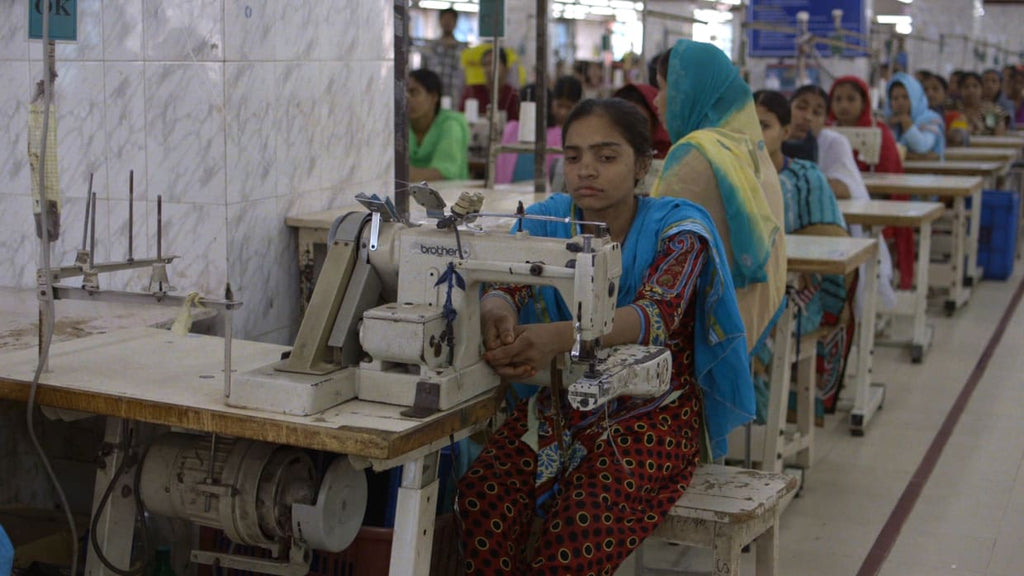(About a 4-minute read)
And if you are too busy to read, you can listen to my recap on our new podcast!
 I need to tell you all about a documentary I watched last year that, I guess now, in retrospect, may have changed the trajectory of my career!
I need to tell you all about a documentary I watched last year that, I guess now, in retrospect, may have changed the trajectory of my career!
One of the main reasons I started Classic Six was my new found stance on fast fashion, and it was only until I started shopping fast fashion in excess for Platinum Penny, did I realize the environmental and social impacts of my choices. These days, when I buy, I look for those timeless silhouettes, not only because they are guaranteed to be the pieces that I will reach for over and over, but because I know they will stand the test of time.
I actually just heard a blogger the other day talking about her new line of sweaters in comparison to a more expensive version she was wearing, and she said “The good thing about my line is that after a season of wear, you don’t have to feel bad about getting rid of it.”
I cringed.
Listen, I am the first to admit that I used to be this girl! Find me a great $5 top in Forever21 and I was buying it. Hey, it was cheaper than a coffee at my local brew shop, and if I wear it once and send it to Goodwill, I’ve gotten my moneys worth.
The problem with that is two fold.
(1)The True Cost
If Forever 21 is selling you a top for $5, it had to cost them pennies to make. When you take a real look at that last statement, you have to wonder…how is it that costs all over the world have gone up, but the price of product has gone down?
A documentary called The True Cost (you can rent on Netflix) has answered this question for me, and I urge you all to add it to your watch list. Here’s my recap:
Big chain stores like Forever 21, H&M, and Zara are all competing with each other for the best price. In doing so, they are going to manufacturers in third world countries like Bangladesh and demanding a lower cost of goods. Brands are hounding these factories for the best price and threatening to leave if they don't get the costs down. Ultimately, they can't say no because they need the business to survive. And when I say survive, I don’t even just mean the business. I mean each individual worker needs this measly income for survival. Because of this, wages are insanely low, some as little as $2 a day, and the working conditions are so poor they are unable to guarantee basic human rights like safety.
 Queue in the jaw-dropping footage from the Dahka, Bangledesh, Rhana Plaza catastrophic collapse of 2013.
Queue in the jaw-dropping footage from the Dahka, Bangledesh, Rhana Plaza catastrophic collapse of 2013.
It is considered the worst garment industry disaster in history. Factory owners had ignored the order to evacuate after workers had pointed out cracks in the walls that may have been structurally unsafe. Structurally unsafe was an understatement. The workers weren't allowed to leave and ultimately paid the price for fast fashion with their lives. The death toll was over a thousand.
The apparel manufactured here were for brands including Joe Fresh, Mango, and Walmart.
Tell me this doesn't change your view on fast fashion, and I will be shocked.
(2) Before you Marie-Kondo your life, read this.

So what happens when you buy that $5 top in Forever 21? Well, you wear it once and then you wind up Marie Kondo-ing your life and it ends up in the donation pile. Don’t get me wrong. I love the idea of donating. It's a win, win. Right? You are cleaning out your closet and helping others. Now what if I told you only 50% of what you donate actually winds up in stores, and only 50% of that is actually sold?
Guess where the rest Is going? IN LANDFILLS...Landfills that sit in piles for 200+ years emitting toxins into the environment—Methane to be exact—a greenhouse gas more potent than carbon.
Sit on that information for a hot second.
Globally, 80% of discarded textiles are doomed for the landfill or incineration. Only 20% are actually reused or recycled.
What can we do?
The question I asked myself after watching this documentary and reading article after article about the impact of fast fashion was this...how can we produce and invest in clothing that still generates economic growth but doesn't take such a toll on humanity and the environment?
The answer runs deep within the soul of Classic Six.
I think a lot about that age-old saying "quality over quantity" and how that mindset in and of itself is a new kind of sustainability. Wouldn't it be incredible to own clothing that is so timeless, beautifully made and loved, it never winds up in a landfill? I can't think of anything I would want more!
So, what SMALL steps can we take right now?
I think it is as simple as being more mindful of our purchases. Take a few minutes when you see something you like to think about how you will wear it. Ask yourself when you will wear it and what you will wear it with. Do you love it so much you can see yourself reinventing it for years to come?
These SMALL thoughts have the potential to create a BIG difference.
xx
D
*Images borrowed from the True Cost Website for educational purposes.








